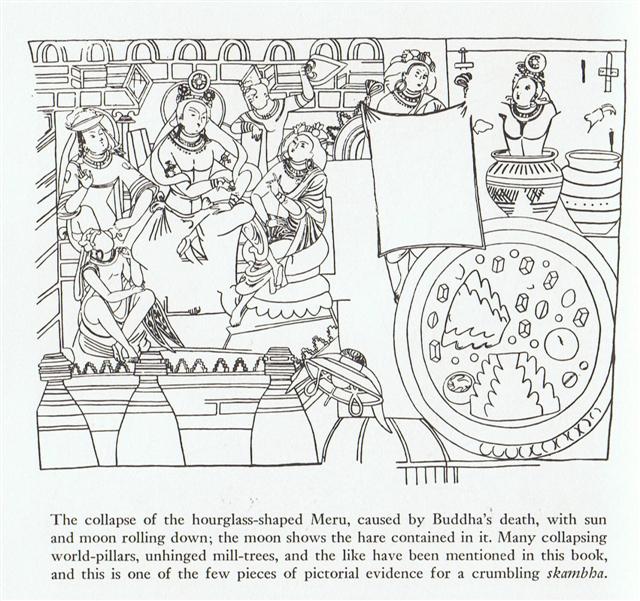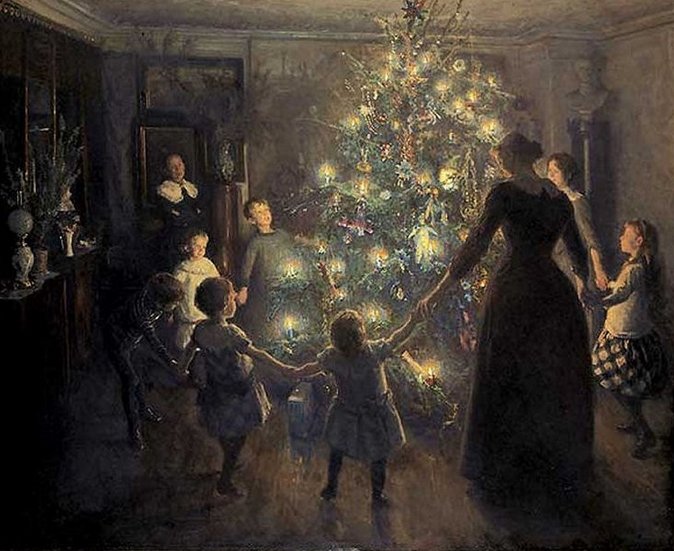From this introduction to the times of the night it should
now dawn
upon us that the C text has underlined the difference between
side a and side b by using eye-catching glyphs in position 6
on both sides of the tablet:
|
side a |
side b |
|
 |
 |
On side a there is a suggestion of 'close embrace' (piri)
- in contrast to the 'separating' on side b.
... They were Ranginui, the
Sky Father, and Papatuanuku, the Earth Mother,
both sealed together in a close embrace. Crushed between
the weight of their bodies were their many children,
whose oppression deepened. They yearned to be free; they
fought their parents and each other to break loose.
Tuumatauenga, virile god of war, thrust and shouted;
Tangaroa of the oceans whirled and surged;
Tawhirirangimaatea, Haumiatiketike and
Rongomatane, of wild foods and cultivated crops,
tried their best but were not successful; and Ruamoko,
god of earthquakes, yet to be born, struggled in the
confinement of his mother's womb ... Of them all,
Taane Mahuta, the god of the forests, was the most
determined; he set his sturdy feet upon his father's
chest, and braced his upper back and shoulders against
the bosom of his mother. He pushed; and they parted. So
the world, as the Maori understand it, came into being
...
We can then interpret the droplet in the center of the
figure on side a as 'water' (high tide, cool, night,
winter) in contrast to day, light, ebb, terra firma -
i.e. the world as we know it.
Cb1-6 has a kind of 'tree' in the center:
|
 |
|
rakau |
Rakau. Raau,
medicine, remedy, drug. Ra'a'u, scratch
on the skin. Rakau, a plant. Râkau,
goods, property. Vanaga. 1. Wood; rakau ta,
cudgel, stick. P Pau.: rakau, tree, to dress
a wound. Mgv.: rakau, wood, timber, a tree;
medicine, a remedy; an object. Mq.: ákau,
wood, tree. Ta.: raáu, id. 2. Medicine,
remedy, potion, ointment, furniture, any precious
object, resources, baggage, riches, heritage, dowry,
merchandise, treasure, wealth; rakau hakaneinei,
purgative; rakau nui, rich, opulent; rakau
kore, poor, beggar, indigent, miserable, an
inferior; hakakamikami ki te rakau, to
impoverish; rakau o te miro, ballast. Mq.:
akau, anything in general. The medicine sense is
particularized in Tonga, Nukuoro, Hawaii, Tahiti,
Mangareva, Paumotu. In no other speech does wood
stand so fully for wealth of possessions, but it
will be recalled that Rapanui is destitute of
timber and depends wholly upon driftwood. Churchill.
I dare suggest that the word rakau equals
ra kau, i.e. that this 'tree' stands at midnight -
that it represents the World Tree.
... The mythic landscape was an
'implex', by which term is meant a world of
implications. ... Fanciful, assuredly, but
neither the Milky Way nor the terrestrial Ganges
offered any basis for the imagery of a river flowing
to the four quarters of the earth 'for the
purification of the three worlds'. One cannot get
away from the 'implex' and it is now necessary to
consider the tale of a new skeleton map, alias
skambha: the equinoctial colure had shifted to a
position where it ran through stars of Auriga and
through Rigel. Skambha, as we have said, was the
World Tree consisting mostly of celestial
coordinates, a kind of wildly imaginative armillary
sphere. It all had to shift when one coordinate
shifted
...
At midnight was the place for the renewal (refreshing) of the Sun:
... His temple-palace was composed of
four radiant apartments: one toward the east, yellow
with gold; one towards the west, blue with turquoise and
jade; one toward the south, white with pearls and
shells; one towards the north, red with bloodstones -
symbolizing the cardinal quarters of the world over
which the light of the sun holds sway. And it was set
wonderfully above a mighty river that passed through the
midst of the city of Tula;
so that every night, precisely at midnight, the king
descended into the river to bathe; and the place of his
bath was called 'In the Painted Vase', or 'In the
Precious Waters' ...
Raa. Sun;
day; i te raá nei, today; raá îka, good
day for fishing. Vanaga. 1. Sun. 2. Day. 3. Time. 4.
Name of sub-tribe. Fischer.
Te manu i te raá = comet. Barthel.
'... The substitution of the sun for the sail, both of
which are called ra or raa in Polynesia,
is a remarkable feature in Easter Island art ... '
Heyerdahl 3. 1. The sun;
raa ea mai,
raa puneki,
sunrise; raa tini,
raa toa,
noon. P Mgv., Ta.: ra,
the sun. Mq.: a,
id. 2. Day, date; a raa
nei a, to-day, now;
raa i mua,
day before. P Mgv., Ta.:
ra, a day. Mq.:
a, id.
Churchill. '... The chief thus makes
his appearance at Lakeba from the sea, as a
stranger to the land. Disembarking at the capital
village of Tubou, he is led first to the chiefly
house (vale levu) and next day to the central
ceremonial ground (raaraa) of the island ...'
(Islands of History)
Ta.: toraaraa,
to raise up. Churchill 2.
LA, s. Haw., sun,
light, day. N. Zeal., ra,
sun, day. Marqu., a,
id. Sam., la, id.
Deriv.: Haw., lae, be
light, clear, shining;
lai, shining as the
surface of the sea, calm,
still; laelae and
lailai, intens. Sam.,
lelei, something very
good; lala, to shine;
lalangi, to broil.
Fiji., rai, to see,
appear; rai-rai, a
seer, a prophet. Teor.,
la, sun. Aru Islands,
lara, id.; rarie,
bright, shining. Amblaw.,
laei, sun, day. Irish,
la, lae, day.
Laghmani (Cabul), la'e,
day. Sanskr., laj,
lanj, to appear, shine;
râj, to shine. Ved.,
to govern; s. a king.
If, as Benfey intimates, the
Sanskrit verb bhrâj,
to shine, to beam, is
'probably abhi-râj',
an already Vedic
contraction, then the
Polynesian root-word al
and lae will reappear
in several of the West Aryan
dialects. Lat., flagrare,
flamma, flamen.
Greek, φλεγω,
φλοξ.
A.-Sax., blac,
blæcan,
&c.
Probably the universal
Polynesian lani,
langi,
rangi,
ra'i,
lanits
(Malg.) designating the
upper air, sky, heaven, and
an epithet of chiefs, refers
itself to the same original
la,
lai,
lanj,
referred to above, to which
also be referred:
Welsh, glan,
clean pure, bright, holy.
Sax. clæne,
clean, pure. Swed.,
ren,
clean. pure; grann
(?), fine, elegant.
It may be noted in
connection with this word,
either as a coincidence or
as an instance of ancient
connection, that in the old
Chaldean the name of the sun
and of the Supreme Deity was
Ra,
and that in Egypt the sun
was also named Ra.
LA²,
s. Haw., Sam., Tong.,
ra.
N. Zeal., the sail of a
canoe; abbreviated from, or
itself an older form of, the
Fiji. laca,
a sail, also the mats from
which the sails were made.
Sunda., Mal.,
layar,
sail. Malg., laï,
sail, tent, flag. Sanskr.,
lâta
(Pictet), a cloth;
latâ
(Benfey), a creeper, a
plant; lak-taka,
a rag. As mats and clothing
in primitive times were made
of bark or flexible plants,
the connection between the
Sanskrit latâ
and Polynesian
laca,
la,
becomes intelligible.
Armen., lôtig,
a mantle. Lat.,
lodix,
a blanket. Irish,
lothar,
clothing. Fornander.
|
In the illustration of Aquarius by Hevelius there is a
dry cloth on one side and a fall (cascade) of water on the other:

This idea seems to correspond to that illustrated in Ca1-6.
And at the top of the World Tree there seems to be a
rectangular blanket, before the Precious Vase:

"Blanket ... †white woollen
stuff XIII ... sheet of soft woollen cloth XIV ..." (English
Etymology)
... The Fijian barkcloth that in the
end captures the chief represents his capture of the
land: upon installation, he is said to hold the
'barkcloth of the land' (masi ni vanua). The
barkcloth thus has deeper significance. In general
ritual usage, barkcloth serves as 'the path of the god'.
Hanging from the rafters at the rear, sacred end of the
ancient temple, it is the avenue by which the god
descends to enter the priest ... There is still more to
the barkcloth. The barkcloth which provides access for
the god/chief and signifies his sovereignity is the
preeminent feminine valuable (i yau) in Fiji. It
is the highest product of woman's labor, and as such a
principal good of ceremonial exchange (soolevu).
The chief's accession is mediated by the object that
saliently signifies women ...

Possibly the position 6 had been chosen because day 366
(January 1) was 6 days after 360 (December 26). I have
written much about this and, for once, I find it
necessary to here insert a
link instead of repeating it all.
Side b follows immediately after Polaris - after a shift
of perspective compared to that at the beginning of side
a.
|
Thuban |
Kochab |
Bharani |
Polaris |
Sheratan |
|
*212.8 |
*225.0 |
*41.4 |
*26.6 |
*27.4 |
In the skambha of Polaris we can count *212.8
(Thuban)
- *41.4 (Bharani) = *171.4 = *185.4 - (*41.4 - *27.4).
Bharani followed 14 days after Sheratan and Sheratan
was 185 days away from Thuban.
In other words, it seems as if there anciently had
been a kind of falling down of the leading star, from the top of the World Tree,

down to us sinful living creatures -
who have to eat each other in order to survive (for
a while).

|
FEBR 11 |
12
(408) |
13 |
14
(45) |
15 |
 |
 |
 |
 |
 |
|
Ca14-29 |
Cb1-1 |
Cb1-2 |
Cb1-3 |
Cb1-4 (396) |
| te
rima |
E tupu -
ki roto |
o te
hau tea |
ki te
henua - te maro |
|
ANA-NIA-10 (Pillar-to-fish by)
χ Ceti (26.1),
POLARIS
= α Ursae Minoris, BATEN KAITOS = ζ Ceti
(26.6),
METALLAH
= α Trianguli
(26.9) |
Al Sharatain-1 /
Ashvini-1 /
Bond-16 (Dog) /
Mahrū-sha-rishu-ku-1 (Front of the Head
of Ku)
SEGIN =
ε
Cassiopeia, MESARTHIM =
γ
Arietis,
ψ
Phoenicis (27.2),
SHERATAN (Pair of Signs)
=
β
Arietis,
φ
Phoenicis (27.4)
*351.0 = *27.4 - *41.4 |
ι Arietis (28.0), λ Arietis (28.2), υ
Ceti (28.8) |
ALRISHA (The Knot)
= α Piscium,
χ Phoenicis (29.2),
ε Trianguli (29.4),
ALAMAK (Caracal)
= γ Andromedae
(29.7)
*353.0 = *29.4 - *41.4 |
Arku-sha-rishu-ku-2 (Back of the Head of
Ku)
2h (30.4)
κ
Arietis (30.3),
HAMAL (Sheep)
=
α
Arietis
(30.5)
ALKES (α
Crateris)
*354.0 = *30.4 - *41.4 |
 |
|
16 |
April
17 (107) |
18 |
19
(80 + 29) |
20 |
|
20 (79) |
'March 21 |
22 |
23 |
24 |
|
... Ecclesiastically,
the equinox is reckoned to be on 21
March (even though the equinox occurs,
astronomically speaking, on 20 March
[*364] in most years) ... |
|
6 (65) |
"March 7 |
8 |
9 |
10 (*354) |

|
|
CLOSE TO THE FULL MOON: |
|
AUG 13 (225) |
14 |
15 |
16
(*148) |
17
(229) |
|
no star listed (209) |
MUPHRID (Solitary Star) = η Bootis
(210.1), ζ Centauri (210.3) |
φ Centauri (211.0), υ¹ Centauri (211.1),
υ² Centauri (211.8), τ Virginis (211.9) |
AGENA (At the Knee) =
β
Centauri
(212.1),
θ
Apodis (212.5),
THUBAN
(Dragon)
=
α
Draconis
(212.8) |
14h (213.1)
π
Hydrae,
χ
Centauri (213.0),
MENKENT (Shoulder of the Centaur) =
θ
Centauri
(213.1) |
|
Oct 16 |
17 (290) |
18 |
19 |
20 |
|
'Sept
19 |
20 |
21 (264) |
EQUINOX |
23 |
|
"Sept
5 |
6 |
7 (250) |
8 |
9 |
|
Itzam-Yeh
defeated |
28 May (148),
3149 BC |
|
1st 3-stone
place |
21 May (141),
3114 BC |
|
Creation of
our present world |
13 August
(225), 3114 BC |
|
Och ta chan
(Hun-Nal-Ye 'entered or
became the sky') |
5 February
(36), 3112 BC |
|
21 May, 3114 BC - 5
February, 3112 BC = 542
which
'happens to be' the sum of
365 days and 6 * 29½ nights. |

... This pot
depicts one of the Hero Twins
(One-Ahaw in the Classic texts and
One-Hunaphu in the K'iche' Popol
Vuh) and a great bird who is trying
to land in a huge ceiba tree heavy
with fruit. This mythical bird is
Itzam-Yeh, Classic prototype of
Wuqub-Kaqix, 'Seven-Macaw',
of Popol Vuh fame. In that story, in
the time before the sky was lifted
up to make room for the light, the
vainglorious Seven-Macaw imagined
himself to be the sun. Offended by
his pride, the Hero Twins humbled
him by breaking his beautiful
shining tooth with a pellet from
their blowgun. This pot shows
One-Ahaw aiming at the bird as he
swoops down to land in his tree. As
Itzam-Yeh lands on his
perch, the
text tells us he is 'entering or
becoming the sky'.
This particular 'sky-entering' is
not the one mentioned in the
Palenque text. It is the final event
that occurred in the previous
creation before the universe was
remade. Before the sky could be
raised and the real sun revealed in
all its splendor, the Hero Twins had
to put the false sun, Itzam-Yeh,
in his place. If the date on this
pot corresponds to that
pre-Columbian event, as we believe
it does, then Itzam-Yeh was
defeated on 12.18.4.5.0.1 Ahaw
3 K'ank'in (May 28, 3149
B.C.). After the new universe was
finally brought into existence,
First Father also entered the sky by
landing in the tree, just as
Itzam-Yeh did ...
|
... Then the big Fish did swallow
him, and he had done acts worthy of blame. Had it
not been that he (repented and) glorified Allah, He
would certainly have remained inside the Fish till
the Day of Resurrection. - Qur'an, chapter 37
(As-Saaffat), verse 139–144. But We cast him forth
on the naked shore in a state of sickness, And We
caused to grow, over him, a spreading plant of the
gourd kind. And We sent him (on a mission) to a
hundred thousand (men) or more. And they believed;
so We permitted them to enjoy (their life) for a
while. - Qur'an, chapter 37 (As-Saaffat), verse
145–148 ... [148 = 4 * 37]

|











